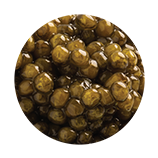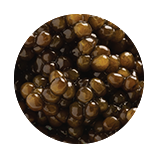Caviar is an entire spectrum of flavor, color, and texture shaped by the fish it comes from. The word itself technically belongs to roe from sturgeon, whose eggs have been harvested for centuries along the Caspian and Black Seas.
That’s where you find the classics: Beluga with its large, buttery pearls; Osetra with its golden, nutty grains; and Sevruga with its smaller, more briny pop.
Today, the market is broader. Farm-raised sturgeon caviars now rival wild-caught traditions, while salmon, trout, and even paddlefish roe offer more approachable entry points.
To the untrained eye, they may all look similar but each variety brings a distinct character, and with it, a very different price tag.
If you’re looking to try caviar for the first time, the key is knowing which type fits your palate and occasion. This guide will help you compare taste, texture, and value across the main types of caviar - so you can enjoy them the way connoisseurs have for centuries.
Want to taste what makes each variety unique?
Order caviar online and explore selections chosen for their authenticity and sustainable origins.
What Are the Three Main Types of Caviar?
When most people picture caviar, they’re thinking of sturgeon. Among sturgeon caviars, three stand out as the most iconic: Beluga, Osetra, and Sevruga. Each is defined by its egg size, flavor profile, and rarity, which also influences price.
Beluga Caviar
The largest and most luxurious pearls, ranging from pale silver to dark grey. Beluga is prized for its buttery, delicate taste and smooth texture. It’s the classic choice for unforgettable celebrations.
Osetra Caviar
Golden to brown eggs with a firm bite and a nutty, complex flavor. Osetra is versatile - elegant enough for weddings and fine dining, but balanced enough for everyday indulgence among caviar lovers. Beluga and Osetra define two ends of the caviar spectrum - one buttery and smooth, the other nutty and firm. Learn more in Beluga vs. Osetra Caviar.
Sevruga Caviar
Smaller, darker pearls with a saltier, more intense profile. Sevruga is often the most approachable in price, making it popular for larger gatherings or thoughtful gourmet gifts.
Comparison Table: Main Sturgeon Caviars
|
Type |
Egg Size & Color |
Flavor Profile |
Texture |
Typical Origin |
Typical Price Range* |
Best For |
|---|---|---|---|---|---|---|
|
Beluga |
Largest, pale to dark grey |
Buttery, delicate, smooth |
Silky, tender pearls |
Caspian Sea, Iran |
€78-€350 / 30g |
Romantic dinners, luxury gifting |
|
Osetra |
Medium, golden-brown |
Nutty, rich, complex |
Firm, satisfying pop |
Russia, Iran, Israel |
€64-€350 / 30g |
Weddings, fine dining |
|
Sevruga |
Small, dark grey |
Briny, salty, intense |
Crisp, lighter texture |
Caspian & Black Sea |
€80-€180 / 30g |
Larger gatherings, gifting |
*Prices are approximate and vary by rarity, source, and grade.
While these three define the classics, today’s caviar world also includes hybrids like Kaluga (a creamy alternative to Beluga) and American Hackleback, as well as roe substitutes such as salmon and trout that bring bold color and approachable pricing. We’ll explore those in more detail below.
What Is the Best Type of Caviar?
The truth is, there isn’t a single “best” among the many types of caviar - the right choice depends on the moment you’re buying for, the flavors you enjoy, and how much you want to spend.
At Om Caviar, we guide customers by balancing luxury with practicality, so every tin feels like the right match.
- For pure luxury → Beluga remains the most celebrated. Its silky, buttery pearls and rarity make it the go-to for unforgettable dinners and gifting.
- For balance → Osetra is often the favorite. With its nutty, complex flavor and firm pop, it delivers elegance without being as delicate (or costly) as Beluga.
- For value → Sevruga is an excellent choice. Its smaller grains pack a punch of briny intensity and offer an accessible entry point for those looking to enjoy authentic sturgeon caviar at a lower price.

If you’re new to the world of roe, we recommend starting with approachable options.
Hackleback and Sevruga are both excellent introductions to caviar’s unique taste. You can also read our guide on the best caviar for beginners for more tips on choosing your first tin.
Detailed Look at Popular Caviars
- Beluga Caviar → Large, pale-to-dark grey pearls with a creamy, buttery flavor and smooth finish. The most luxurious and rare.
- Osetra Caviar → Medium-sized golden-brown grains, nutty and complex, with a firmer bite. Elegant and versatile.
- Sevruga Caviar → Small, dark grey eggs with an intense, salty profile. Affordable and bold.
- Kaluga Caviar → A sustainable hybrid often compared to Beluga. Creamy, buttery flavor with a rich texture, but more accessible in price.
- Hackleback Caviar → Native to American rivers, Hackleback is earthy and approachable, making it popular for casual gatherings.
- Sterlet Caviar → Rare and delicate, with tiny golden-to-grey eggs and a subtle nutty profile. Historically prized at royal courts.
- Salmon Roe (Ikura) → Bright orange pearls, briny and bold, with a pop that makes them a favorite in sushi. Not sturgeon, but widely enjoyed.
- Trout Roe → Slightly sweeter than salmon roe, with pink-orange eggs and a lighter profile, often used in fine dining and garnishes.
While today’s market includes hybrids and roe from species like salmon and trout, it’s important to remember that true caviar comes only from sturgeon.
Other varieties, though similar in appearance, are technically classified as roe. You can read more about the difference between caviar and fish roe before exploring how color and species shape flavor.
Black Caviar vs. Red Caviar
When people talk about caviar, they often mean one of two things: black caviar or red caviar. The difference begins with the fish itself and extends to how the roe is harvested and served.
Black Caviar
Black caviar is made from sturgeon roe, harvested from species like Beluga, Osetra, and Sevruga that have defined caviar’s reputation for centuries.
The color ranges from silvery grey to deep black, and the pearls are smaller, glossier, and more structured. Black caviar carries an unmistakable sense of heritage - it’s the variety once reserved for royalty and still recognized as the benchmark of luxury today.
Red Caviar
Red caviar, by contrast, comes from salmon or trout. Its translucent orange-red pearls burst gently when eaten, releasing a clean, briny flavor.
Red caviar has long been part of everyday celebrations in Russia, Scandinavia, and Japan. While it’s less rare than sturgeon roe, its vivid color and approachable taste make it a favorite for festive occasions and sushi dishes alike.
Comparison Table: Black vs. Red Caviar
|
Type |
Source Fish |
Color & Appearance |
Heritage & Culinary Role |
Availability & Appeal |
|---|---|---|---|---|
|
Black Caviar |
Sturgeon (Beluga, Osetra, Sevruga) |
Grey to deep black, glossy pearls |
Traditional luxury served in royal courts; hallmark of refinement and ceremony |
Limited, high-end delicacy prized for authenticity |
|
Red Caviar |
Salmon / Trout |
Bright orange to red, translucent pearls |
Celebratory staple in Russian and Japanese cuisines; vibrant and approachable |
Widely available and favored for color and versatility |
What Is the Most Buttery Caviar?
The most buttery caviar is Beluga. Beluga caviar comes from sturgeon in the Caspian Sea and is famous for its large, pale-to-dark grey pearls. The flavor is smooth, delicate, and unmistakably buttery, making it the reference point for luxury caviar.
A close alternative is Kaluga caviar. Kaluga is a hybrid sturgeon roe that mimics Beluga’s creamy flavor but is more available and less costly. Its medium-to-large grains are rich, smooth, and slightly nutty, offering a buttery taste without the extreme rarity of true Beluga.
“Buttery” caviars pair best with subtle accompaniments. Champagne, vodka, and blinis are classic pairings because they highlight the creaminess. For more ideas, see our guide to the best caviar pairings.
First-time tasters often ask - what does caviar taste like? The answer is that taste varies by species, but Beluga and Kaluga are known as the most buttery options available.
Caviar Rarity Scale
Not all types of caviar are equally rare or expensive - their value depends on species, age, and how long the sturgeon takes to mature.
Here’s how the best-known types compare by rarity and prestige.
Ranked from Common to Legendary
- Almas Beluga - The rarest caviar ever produced, made from the eggs of albino Beluga sturgeon found in Iran’s Caspian Sea.
- Beluga - The definition of luxury. Harvested from sturgeon that take up to two decades to mature.
- Golden Osetra - The color alone makes it rare, and its balanced flavor keeps it among the most sought-after caviars.
- Kaluga Hybrid - A modern luxury born from sustainable aquaculture. This hybrid between Kaluga and Amur sturgeon offers Beluga-like creaminess at a more attainable level of rarity.
- Osetra - The most versatile of the premium caviars. Medium-sized eggs, a firm texture, and complex nutty notes make Osetra the reliable standard of fine dining.
- Sevruga - Smaller, saltier, and more abundant than its relatives, Sevruga provides an authentic caviar experience at a friendlier price.
- Hackleback - An American classic from wild sturgeon in the Mississippi River basin. An accessible introduction to the world of true caviar.
What Is the Most Expensive Caviar?
The most expensive caviar in the world is Almas caviar, a rare variety of Beluga roe harvested from albino sturgeon found in Iran’s Caspian Sea.
Almas is prized for its golden color and extreme scarcity. Prices can reach up to $25,000 per kilogram, making it one of the most luxurious foods on the planet.

Outside of Almas, Beluga caviar generally holds the top position for price and exclusivity.
Beluga sturgeon take nearly 20 years to mature, and their delicate, buttery pearls are limited in supply, which keeps costs high.
Following closely behind is golden Osetra caviar, valued for its nutty, rich flavor and golden-brown grains.
Comparison Table: Expensive & Rare Caviars
|
Type |
Origin |
Flavor Profile |
Rarity Factor |
Typical Price Range per Kilogram* |
|---|---|---|---|---|
|
Almas (golden Beluga) |
Iran, Caspian Sea |
Buttery, delicate, creamy |
Albino Beluga sturgeon, extreme scarcity |
$20,000-$25,000 / kg |
|
Beluga |
Caspian Sea |
Buttery, smooth, mild |
20-year maturation, limited harvests |
$7,000-$10,000 / kg |
|
Golden Osetra |
Russia, Iran |
Nutty, rich, complex |
Unique golden eggs, limited availability |
$4,000-$7,000 / kg |
*Prices are approximate and fluctuate based on grade, source, and availability.
Caviar for Different Occasions
Not every tin of caviar belongs at the same table. The right choice depends on the event, the mood, and how you want the experience to feel.
At Om Caviar, we often guide customers by pairing caviar with moments - whether it’s a romantic dinner, a wedding celebration, or a casual gathering with friends.
Comparison Table: Choosing Caviar by Occasion
|
Occasion |
Recommended Caviar |
Flavor & Texture |
Why It Fits |
Approx. Price Range* |
|---|---|---|---|---|
|
Romantic dinner / anniversary |
Beluga Hybrid |
Buttery, silky pearls |
Luxurious and unforgettable, perfect for creating intimacy |
$155-$300 / 30g |
|
Formal celebration (weddings, milestones) |
Osetra |
Nutty, firm, golden-brown |
Elegant and versatile, a refined choice for larger gatherings |
$150-$200 / 30g |
|
Corporate event or gifting |
Sevruga |
Briny, crisp, small grains |
Affordable yet authentic, works well for group tastings |
$80-$150 / 30g |
|
Casual gathering with friends |
Hackleback |
Earthy, approachable, firm pop |
American sturgeon caviar that offers luxury at a more relaxed price |
$50-$70 / 30g |
|
Festive holidays (New Year’s, Christmas) |
Kaluga |
Creamy, buttery, rich |
Close to Beluga in flavor, but more available for holiday feasts |
$75-$250 / 30g |
The Essence of Caviar
Each type of caviar reveals its own nuance - a shift in texture, a change in depth, a distinct expression of flavor.
Beluga is smooth and buttery, Osetra is layered and nutty, and Sevruga carries a sharper, brinier edge. Together, they show how subtle variation transforms caviar from a single delicacy into a whole range of experiences.
At Om Caviar, we believe choosing caviar should feel like discovery, not decision-making.
When you understand what makes each variety unique, you start to enjoy it the way it’s meant to be - with patience, curiosity, and appreciation for craft.
Taste the difference craftsmanship makes.
Discover our signature caviar selection, curated to showcase the finest varieties from sustainable sources.
FAQ
1. What are the best types of caviar to buy for a luxury dining experience?
For a refined dining experience, Beluga remains the gold standard - known for its large, silky pearls and buttery finish. Golden Osetra is another top choice, offering a rich, nutty depth that pairs beautifully with champagne or fine wine. For something slightly more modern and sustainable, Kaluga hybrid caviar offers the same creamy texture as Beluga with a gentler price and consistent quality.
2. How do you choose between the main types of caviar when shopping online?
Start by considering your taste preferences and the occasion. If you prefer a smooth, delicate flavor, Beluga or Kaluga are ideal. For something nutty and balanced, go for Osetra. And if you enjoy a brinier, more intense taste, Sevruga is a great match. Reading product descriptions, origin notes, and texture details helps ensure you select a variety that fits your palate and your plans.
3. Which types of caviar offer the best taste for first-time buyers?
If you’re new to caviar, start with milder, more approachable options like Sevruga or Hackleback. They deliver authentic sturgeon flavor without the intensity or cost of Beluga. You can also explore our Best caviar for beginners guide for tailored suggestions based on flavor, texture, and budget.
4. Where can I order premium types of caviar for home delivery?
You can order caviar online directly from Om Caviar. Our collection features premium sturgeon caviars all sourced responsibly and delivered chilled to preserve quality. Each tin is carefully inspected for freshness, ensuring a luxury experience from packaging to palate.


